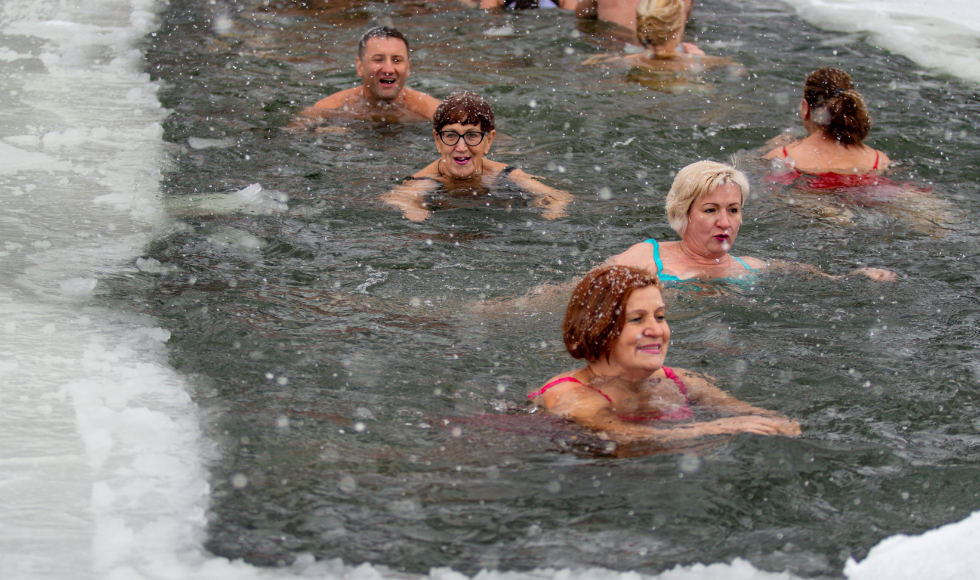Handy tips for polar bear dips

Never dive, always bring a friend and maybe take it slow. Cold-water swimming expert Lee Hill shares tips and wisdom in time for polar bear dip season. (Shutterstock image)
BY Sonia Verma
December 22, 2022
New Year’s Day is a busy time for Canadian lakeshores and riverbanks, as daredevils gather to take the plunge — the polar bear plunge.
We talked to Lee Hill, a research coordinator in McMaster’s Faculty of Health Sciences and the co-author of a research review on the benefits and risks of cold water swimming.
Hill, a former Olympic swim coach and an winter swimmer himself, is currently a postdoctoral fellow at McGill University, after doing his PhD in exercise science, studying musculoskeletal injuries in swimmers.
Here, he answers questions and shares insight on the safest way to indulge in the polar bear dip.
What happens to the body when you suddenly plunge into icy water?
Lee Hill: Being immersed in cold water can cause a drastic drop in blood pressure or make your heart rate skyrocket in the first couple of seconds.
You will hyperventilate — breathing can increase 600 to 1,000 per cent in the first few seconds — so your chances of passing out become very high.
In addition to this, when you subject your body to cold shock, you have trouble thinking clearly; blood gets diverted away from extremities, making it hard to move; nerves stop firing, which also makes it harder to move properly; the vagus nerve is stimulated.
What should a person who isn’t a habitual cold-water swimmer keep in mind if they’re contemplating a polar dip?
First, it’s wise to check in with your doctor before you subject your body to an extreme shock like this.
Then, from a safety standpoint: Don’t do it alone. If you’re going to suddenly immerse your body in icy water, you should do it with someone on standby so they can keep an eye on you.
Never dive in, ever, ever. That’s how you drown. Even habitual cold water swimmers never dive in.
OK, no diving. How about jumping in — the whole “rip off the bandage” philosophy?
People like to run in and get it over with, but ideally, you should go in slowly to prepare your nervous system for the cold immersion that’s coming. Begin by putting your feet in, then get your hands wet. Splash cold water on the back of your neck. Now your body is acclimated and you can go in more safely.
Let’s say you like it and are cleared to do the dip safely: How long should you stay in there?
There’s a researcher named Gordon Giesbrecht who’s an expert on cold water survival and is even called Dr. Popsicle or Dr. Freeze. He coined the term 1-10-1:
It takes one minute to get your breathing in control after that sudden gasp. Use that first minute to get your body’s panic under control: Keep your airway above the water; it’s very easy to hyperventilate and you don’t want to faint.
Now you have 10 minutes of good, co-ordinated movement where your muscles and nerves are able to move really well. After 10 minutes you’ll begin to experience cold incapacitation.
And then the final one: There’s a myth that hypothermia happens very quickly when you get cold. But your body has checks and balances to keep you safe — there’s peripheral vasoconstriction (peripheral blood vessels constrict), goose bumps to conserve heat, your body turns off the kidneys and anything else you don’t need. Even immersed in ice water, you have approximately an hour before you’d lose consciousness.
And how about after the swim, anything to keep in mind?
Once you’re done with your dip or swim, stay with people for a few hours. That’s because one thing we also observe is a “secondary drop,” when all that cold blood in your extremities warms up and is back in circulation. That can slow your heart and drop your blood pressure an hour or two later. If you’ve been hypothermic, it takes a few hours to make sure you’re staying warm.
Is there a health benefit to an annual polar bear plunge?
There is just not enough research to support sweeping claims of its health benefits. Even if cold water dips were beneficial — and there’s scant research on this — to truly derive a benefit for your body, you’d have to do it habitually. If you do it once a year, you’ll get very limited or no benefit.
Duration matters too: Polar dips don’t last long. You run in, immerse yourself, run out, have a laugh. I’d say maybe it’s good for your social health, especially if you do it with friends.
For most, a polar dip is a rite of passage, a fun thing to do to kick your year off with an experience you can talk about.
What makes plunging into icy water a fun experience?
There’s a thrill of survival when we think about doing these extreme activities. Immersing yourself in cold water puts your body in survival mode — it’s working to prevent hypothermia and keep you alive.
A lot of those survival functions happen without conscious thought on your part. One of them is that your body floods your system with feel-good hormones: Adrenaline, dopamine, norepinephrine. These are survival hormones that literally give you a reason to live, because your body is telling you, “please stay alive.” So, in a very literal sense, there is a thrill of survival.
As well, when dopamine is released, it creates long-term potentiation of memories, reinforcing memories so when you look back you think: It was scary and cold and I really enjoyed it.
And of course, there are bragging rights.


